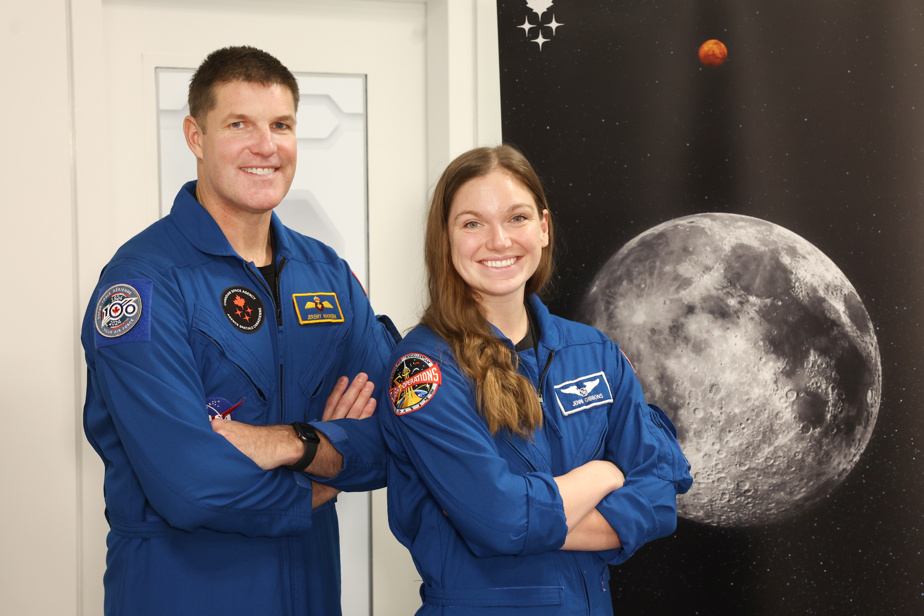Canadian astronauts Jeremy Hansen and Jenni Gibbons believe they have a chance of making a trip to the Gateway lunar orbital station, which is scheduled to begin operating in 2028. Monday, during a media day at the Space Agency in Saint- Hubert, they talked about Canada’s future on the Moon.
“Yes, it could happen,” said M.me Gibbons, when The Press asked if she could be nominated for a mission on the Gateway station, which will be operational in lunar orbit from 2028. To the same question, Mr. Hansen replied “maybe”, while emphasizing that he is very possible that a Canadian astronaut will stay on Gateway.
Mr. Hansen, a 48-year-old fighter pilot, will be part of Artemis II, a manned mission that will circle the Moon in September 2025. Mme Gibbons, a 35-year-old engineer, is his replacement if he is unable to fulfill his mission.
Both ruled out the possibility that they were part of a Mars mission. “I think the people who will go to Mars are born, but they are younger than me,” Ms.me Gibbons in interview with The Press.
Artemis II was due to take off in 2024, but an anomaly occurred in the capsule’s heat shield Orionduring the unmanned Artemis I mission. “The shield reacted well, but its appearance [après l’amerrissage] was not what was predicted by the modeling, says Mr. Hansen. We wanted to be sure that what we saw with Artemis I was the worst that could happen. »
No Canadians will be part of the Artemis III mission, which will set foot on the lunar surface in 2026.
Canadian arm
The Gateway station, whose construction is scheduled to begin in 2025, will include the third version of the Canadian robotic arm, after those of the space shuttle and the International Space Station (ISS).
“The goal is to make an arm that will be marketable,” explains Ken Podwalski, director general of the Gateway Program at the Space Agency. “The ISS is scheduled to last until 2030 and even if it is extended, there could be private space stations. So we want to position ourselves for this development. »

PHOTO ROBERT SKINNER, THE PRESS
Jeremy Hansen, Ken Podwalski and Jenni Gibbons pose with a model of the Canadian arm of the space station on Monday.
The Space Agency has entrusted the development of Canadarm3, whose budget is estimated at $1.9 billion, to the Toronto firm MDA, which also built the first two Canadian arms.
The Canadarm3 will be composed of three sections: a large arm measuring 8.5 meters, half the size of the ISS’s Canadarm2, a small arm capable of more precise manipulations, like the Dextre manipulator of the Canadarm2, and a “toolbox” . It is expected to be installed on Gateway a month before Artemis 5, Gateway’s first manned mission. “We want to test the robotic arm before the astronauts arrive,” says Mr. Podwalski.
Gateway’s orbit will be permanently located between the Earth and the Moon. It will approach 70 km from the Moon, which will allow the transfer of astronauts to the lunar surface.
Potable water
The Canadian Space Agency has launched several lunar programs for the private sector. The $150 million Lunar Exploration Acceleration Program (LEAP), launched in 2020, will include exploration rovers and communications and navigation systems.
Lunar exploration in pictures
-

IMAGE TAKEN FROM NASA SITE
Artistic illustration of the Gateway Lunar Station
-

IMAGE TAKEN FROM THE CANADIAN SPACE AGENCY SITE
Artistic illustration of the Canadian arm of the Gateway Lunar Station
-

PHOTO TAKEN FROM NASA SITE
Swimming pool landing practice in January for the Artemis II crew
-

PHOTO TAKEN FROM NASA SITE
Landing of the capsule Orion of the Artemis I mission
-

PHOTO TAKEN FROM NASA SITE
Artistic illustration of the Nova-C probe
-

PHOTO TAKEN FROM NASA SITE
Artistic illustration of the Viper probe
1/6
In January, the Space Agency also launched the “Aqualunary challenge”, which aims to develop systems for purifying the water that will be extracted from lunar ice. “Because of weightlessness and the absence of an atmosphere, we cannot use terrestrial purification systems directly,” says Martin Giguère, manager responsible for Aqualunaire at the Agency. “We also want to limit the need to bring in supplies. Water purification systems need a lot of reagents right now. »
Two other similar Space Agency challenges, which aimed to develop food production systems and space health care, attracted around 60 companies. The team that wins the Aqualunaire challenge will receive a $400,000 grant.
American lunar probes, notably during the private Nova-C mission and NASA’s Viper mission, will test ice extraction this year. “With Aqualunaire, we are taking a leap forward,” says Mr. Giguère. We will examine the challenges that will arise when we can extract water from lunar ice. »
Learn more
-
- 28 billion US
- Artemis program budget
Source: NASA
